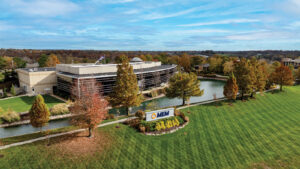From wild beginnings, Gold Nugget keeps cooking up fun on Columbia streets
David Hestir has got a lot of nerve.
No, not the kind of nerve that makes him unapproachable. You’ll be hard pressed to find anyone in Columbia so generous with a story, so quick to settle in and share a conversation with a customer or so eager to lend a hand to a neighbor. His kind of nerve is all about being willing to take a risk.
Hestir, 43, once piloted a medical-evacuation plane through treacherous mountain passes in the Alaskan wilderness, occasionally rescuing victims of bear attacks. He was a paramedic, racing to crash scenes and treating the critically ill or injured.
Then he abandoned a successful career he loved and drove across the country to rejoin his family in mid-Missouri, where he started an unconventional food-service business, selling popcorn, sausages and root beer at a sidewalk cart hauled around Columbia and environs.
And now, Hestir is planning to open his own store somewhere in Columbia, a general store like the one his grandmother ran in Macon, a town about an hour’s drive north of Columbia.
Anyone who has strode up to Hestir’s sidewalk cart when it’s parked at Lowe’s, on a downtown street or at a festival smells the tantalizing aromas of the brats and Italian sausages wafting from his open cart and catches a glimpse of the ice-cold root beer he serves to wash it all down.
Then they hear the pitch. “They are the best you’ll ever eat,” Hestir barks about his Italian sausages. “It’s like a brat that went on vacation in Sicily and decided to stay. Believe me; you’ve never had anything like it.”
Hestir creates the atmosphere of a Seattle fish market. He teases customers and their children, riffs sarcastically and unabashedly about politics, follows a Cardinal’s game on the radio, or bops along to the blues tunes coming from his speaker system.
The kernel of Hestir’s business, Gold Nugget Popcorn Co., is the corn kernel, a seed he became intrigued with way back in the early days of bush-piloting.
Popcorn seemed to represent for Hestir all things held dear: working and cooking with relatives, having fun, keeping traditions alive, and celebrating old-fashioned Americana. It brought back memories of his Italian-born grandmother—whom he calls his “Granjo”—and her grocery store, Granjo’s.
Hestir remembers fondly his grandmother’s skill in the kitchen and, of course, the special seasonings she added to her own popcorn that made it, in his words, “fabulous.”
One night after work in Alaska, Hestir started talking with a fellow pilot, Jack Nisen, and the conversation turned to the subject of breaking into the popcorn business.
Nisen, who holds a degree in physics from the University of California-Berkeley, approached the idea from a scientific perspective: weights, measures, heat and pressure. This approach was simply too esoteric for Hestir. For him, it was all about cooking, experimenting, taste and just plain fun. Eventually, Hestir’s creative enthusiasm merged with Nisen’s practical side, and the two began trying different combinations of ingredients.
Finding just the right combination was a lengthy process of trial and error. The two still made regular Medevac calls, but in their spare time they worked on blends of corn seeds, pure Alaskan honey and birch-bark syrup.
“We burnt the first 200 pounds to the ground,” he recalled with a laugh. When they were finally satisfied with the sweet-and-salty, kettle-popped corn, it was time to test it out on a wider audience.
Wider indeed. Hestir and Nisen were called to make a 1,600-mile medical-rescue flight to the Aleutian Islands off the coast of Alaska, where the Coast Guard had pulled a crab fisherman from the icy sea. After they’d stabilized their patient and were preparing to leave, they casually handed over a bag of popcorn for the Coast Guardsmen to sample.
About a week later, they got a call from the remote island chain, and the radio operator implored them to “remember the popcorn next time you guys come out this way.” Hestir laughed while describing the radio operator’s indignant reception when the pilots returned empty-handed. “He said to us, ‘Look, living out here on an island is pretty rough. We get news here a week after it happens. We rarely see things like hamburgers, ice cream or soda pop. So the next time you come out here and forget the popcorn, you might find that you and your buddy have to wait a week to get refueled.’’’
They took the threat as a compliment and soon were popping their corn at carnivals, dog sled events and festivals in far-flung places such as Barrow, Sitka, Juneau and Nome.
Clearly, they’d created something desirable. But what would possess a man to leave a career he was passionate about, hitch his trailer and “extreme kettle corn machine” to the back of his truck, and drive the 4,264 miles from Anchorage to Columbia, Mo., to start over?
It was something he was even more passionate about than flying or the Alaskan wilderness: his children.
Following their divorce, Hestir’s ex-wife had relocated with their three children to Sedalia. Hestir followed in 2004 and returned to his former career as a paramedic, working with the Randolph County Ambulance District.
His schedule, two back-to-back 24-hour shifts with days off in between, allowed him time to build the popcorn business, which now sells brats and Italian sausage along with popcorn and hotdogs, and includes his family. Daughter Megan, 16, bags the corn (and inspired the design of the “Race Dogs” logo on the company trailer when she was 9). His sister labels the bags. His mother picks up buns from the grocer and runs other errands. Girlfriend Anita Zaph manages to keep him organized. His 11-year-old twin sons, Bailey and Ben, have also pitched in. Everyone, including his police-officer younger brother takes a turn serving customers from time to time.
For his customers, Hestir says emphatically that he doesn’t serve “just any” sausage or popcorn. His family’s relationship with Scimeca’s Italian Sausage Company in Kansas City dates back to his grandmother’s grocery store days. Hestir kept in touch with Scimeca’s even during his years in Alaska. When he returned to Missouri, he formalized the relationship and has now earned a distributorship—a territory nearly as big as Alaska that extends from Columbia eastward to the Atlantic Ocean.
Hestir makes a weekly trip to Kansas City, arriving at Scimeca’s promptly at 5 a.m. to pick up his order. He often takes orders for the sausages for his customers, but he warns, “They better not be late to pick ‘em up.” He’s very clear about what happens: “I tell them, ‘Keep ‘em cold, and pick ‘em up on time. If you’re not there to pick up your order, I’m gonna cook ‘em, because I know there will be people who will want to eat ‘em.’ I know it sounds a little rude, but I think people appreciate it that I care about the food.”
With the exception of his hot dogs, bought from Nathan’s of Brooklyn, Hestir believes in buying from Missouri suppliers. He gets Fitz’s root beer from St. Louis, and he substituted local honey for Alaskan birch bark syrup.
Most important to Hestir is the corn seed he uses to make popcorn. Hestir studied the origins of the snack and traced it to the Wampanoag Native Americans, who lived in the area surrounding Plymouth, Mass. Popped corn was one of the main dishes the Wampanoag people contributed to the First Thanksgiving, and it was used as a method of trade among the New England settlers and the indigenous peoples.
Ultimately, Hestir began visiting Larry McDonald’s mid-Missouri farm, the source of his annual supply of corn seed (about 40 50-pound bags) and is learning all about the planting, nurturing and harvesting.
Hestir has hit dead ends on occasion when contacting some companies to propose a working relationship. Some flatly turned him away, and others, he quips, “’lost’ my phone number six times.” When he called on Fitz’s, however, he was invited to the offices in St. Louis, taken out to lunch and sent home with a keg of root beer.
Hestir said he is impressed and honored by the encouragement, advice and support given by Columbians, particularly store owners who have shared everything from ingredients to trade publications.
“It’s all about helping people out. A lot of people have helped me,” Hestir said.
John Pham, owner of Bangkok Gardens, has supplied onions and other ingredients when Hestir has run out. Taco Bell franchise owner Dave Dunofan passed on trade magazines, and Jack Tutt at Sir Speedy Printing rushed a label order to help fill Christmas Eve orders. Others he credits are Dave and Shari Hackett from IB Fruits and Nuts, Tony Beckett at Applied Graphics and Mike Monahan of Jimmy John’s restaurants. Paul Zacharias, owner of Uncle Paulie’s Store at 9th and Cherry streets, lets Hestir set up his food cart outside the store, the closest thing Columbia has to Granjo’s, the market Hestir’s grandmother’s once ran.
To enliven the atmosphere at special events, Hestir has equipped his trailer with a high-definition television, a DVD player, satellite radio and a powerful sound system.
Hestir says there are advantages to a mobile business, such as variable costs and the flexibility to move a product to the greatest concentration of customers. High fixed costs and a dependency on people coming to a fixed site are the chief reasons that popcorn stores have failed in the past, he said.
Hestir still wants to own a store that has a family atmosphere like Granjo’s, and he plans to open one late this year or early next year while keeping the cart business.
For now, the Gold Nugget cart can be found occasionally downtown by Uncle Paulie’s or the Tiger barber shop and every Thursday through Saturday in the Lowe’s home-improvement store near West Broadway and U.S. 63. True to form, he proclaims, “The gang at Lowe’s is the best, from the management team to their associates.”









